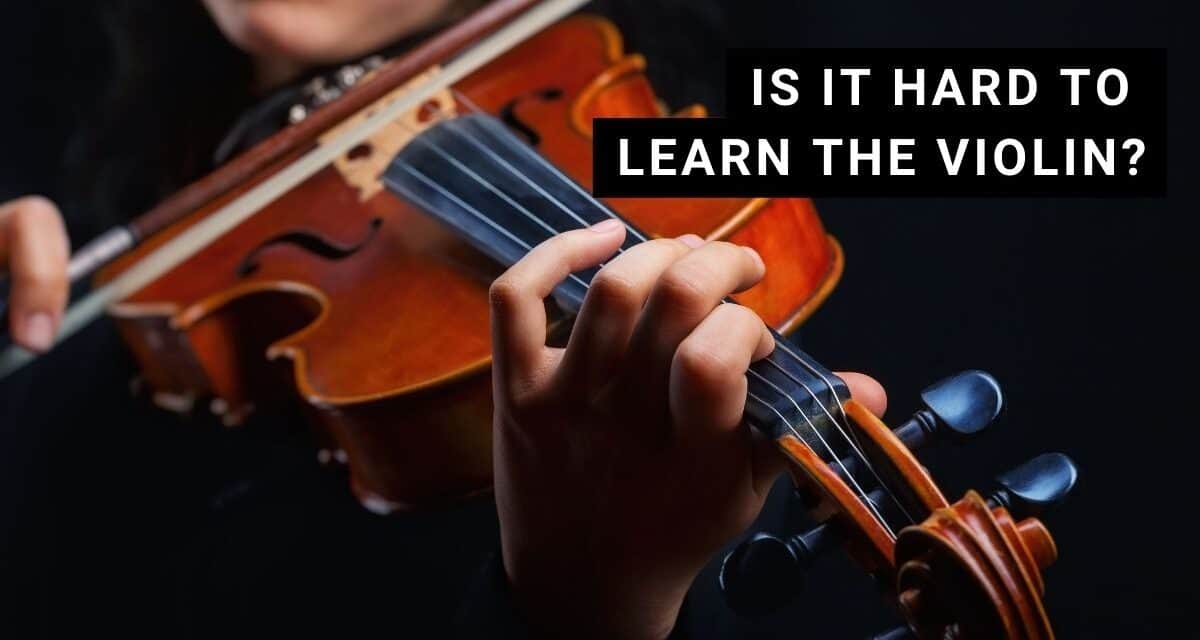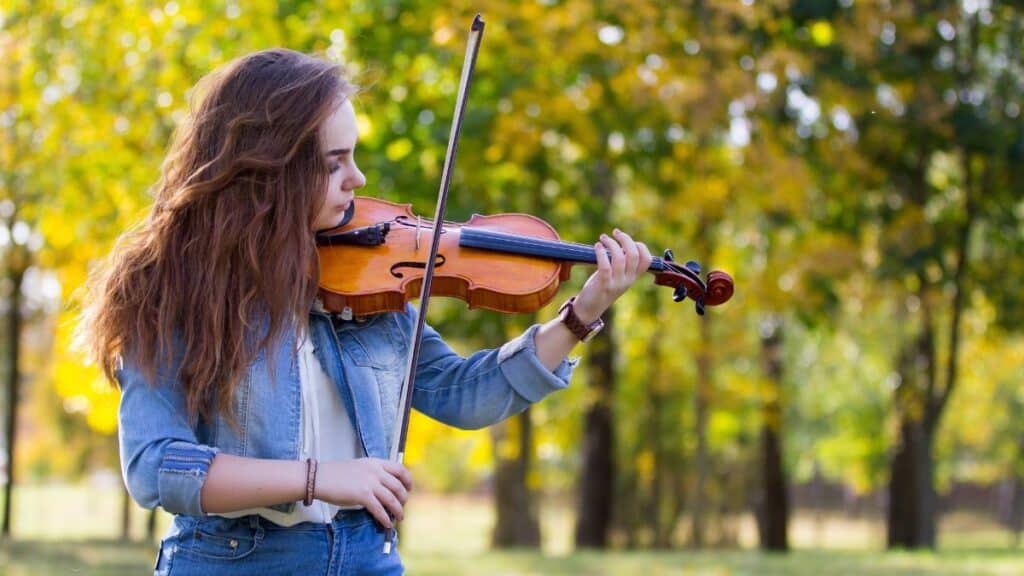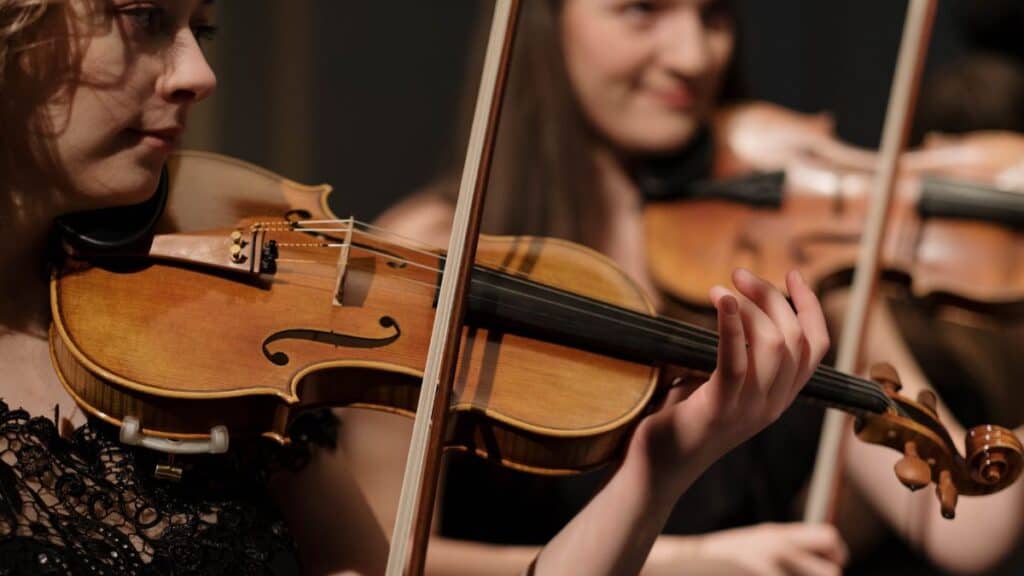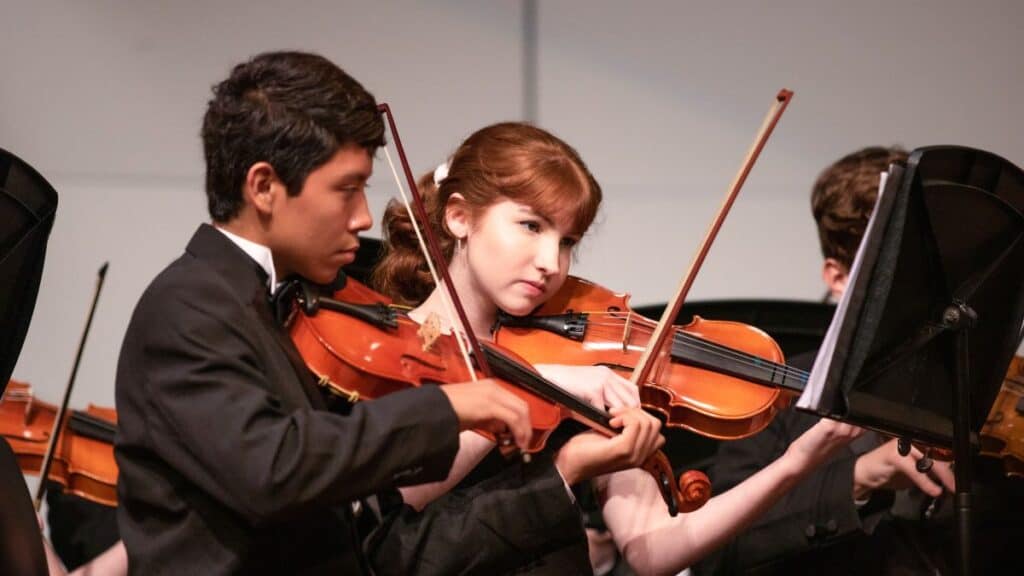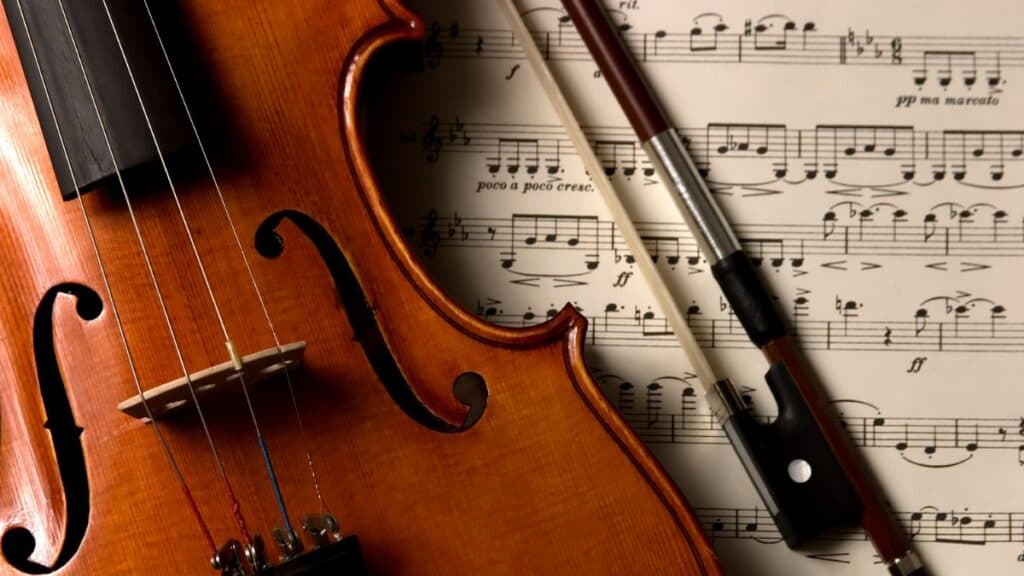Is the violin hard to learn?
In the world of string instruments, the violin is often seen as the crown jewel. Its sweet and alluring sound has enchanted audiences for centuries, and its reputation as an instrument of sophistication and elegance is unquestionable.
But let’s tackle the elephant in the room – just how hard is it to play this sophisticated instrument?
Well, like a mystery novel full of plot twists and turns, the answer isn’t so straightforward.
There is no doubt that the first few years of learning violin take a ton of patience and effort to be playing at a decent level. It is not the easiest stringed instrument to start your musical journey – but with the right attitude and effort, the hard work will pay off with beautiful sound.
Some questions and challenges we look into include:
Do I need violin lessons to get any good?
How do I avoid violin sound that is scratchy or noisy?
What are the best violin strings for a beginner?
How long does it take to play the violin proficiently?
Do I need to learn at a young age?
Is it possible for adult beginners to learn to become professional violinists?
Is the violin hard to learn?
Let’s explore in-depth how hard playing violin might be for beginners and explore some of the challenges you might face when begging to play music with this wonderful musical instrument.
Is the Violin Difficult to Learn?
The short answer is – yes, the violin can indeed be a hard instrument to learn.
It’s not so much that the violin is inherently harder than other instruments, but rather, it demands a certain finesse and patience that can take some getting used to.
Although, if you want to learn violin, there should be nothing holding you back from your passion and no amount of words or articles should sway you otherwise. Learning violin may be a challenge, but it is so worth it and the musical journey is part of the fun.
If you want an easier instrument to learn, then we recommend choosing the acoustic guitar or ukulele – but if you are ready for the challenge, then let’s proceed to learn violin!
The biggest challenges you may face when learning violin:
-
Precision
In the violin world, precision is the name of the game. Even the tiniest variation in finger placement can alter the pitch of a note. So, achieving the correct intonation (playing in tune) can be a meticulous task that requires a keen ear and a steady hand.
-
Physical Demands
Physically, the violin also asks quite a bit from its player. It’s one of the few instruments that you can’t simply pick up and play. You need to learn the correct way to hold the violin and the bow, maintain proper posture, and coordinate the movements of both hands. It’s almost like a dance, where balance, strength, and fluidity come into play.
-
The Bowing Technique
Then, there’s bowing technique, which can be a puzzle all on its own. Controlling the bow to create a smooth, even sound involves a complex interplay of pressure, speed, and bow placement. It’s an art that takes practice to perfect.
The Rewarding Challenge
However, all this isn’t to say that learning the violin is an insurmountable task. Far from it. While it can be challenging, it’s equally rewarding. With each hurdle overcome, you’ll find yourself inching closer to creating the kind of beautiful music that first drew you to learning violin.
Remember, every violinist’s journey is unique, and it’s the effort and dedication you put into learning that truly counts. The journey might have its ups and downs, but the sense of achievement when you finally nail that tricky piece? Now, that’s priceless.
Do I Need Violin Lessons as a Beginner?
Learning a new instrument, especially one as nuanced as the violin, begs the question – “Do I need lessons?”
While self-learning has its merits, for a beginner, violin lessons can expedite the learning process. Let’s delve into why a violin teacher can be helpful for newbies.
-
Personalized Guidance
Violin lessons offer personalized instruction tailored to your strengths and areas for improvement. An experienced violin teacher can spot and correct mistakes in technique, preventing the formation of bad habits that might hinder your progress later on as you play the violin.
There are many violin teachers to choose from and a professional violinist will without a doubt take your violin learning to the next level.
-
Structured Learning
Lessons also provide a structured learning pathway, which can be especially beneficial for beginners. You’ll be guided step-by-step, from basics to more advanced techniques, ensuring a comprehensive and systematic learning process.
A music teacher can also help you learn to read music, which is essential for violin learning.
-
Instant Feedback
Another advantage is the instant feedback you receive from a violin teacher.
Got a burning question or unsure if you’re bowing correctly? Your violin teacher can clarify doubts on the spot, helping you to learn correctly and efficiently.
-
Motivation and Accountability
Finally, regular lessons encourage discipline and consistency – two crucial elements in mastering the violin. Beginners can sometimes find it difficult to find the time for consistent practice and a private tutor can help you build steady progress with a set schedule.
Knowing you have a lesson can motivate you to practice regularly for a few weeks, and your teacher can hold you accountable, helping to keep your learning on track.
While it’s possible to learn and play violin independently, especially with the wealth of resources available online, the guidance and structure that lessons offer can be invaluable, particularly in the early stages of your violin journey.
They can help you to not only learn violin but to enjoy the process, keeping that spark of passion alive.
Understanding the Violin
Before you can run, you’ve got to learn to walk, right?
In our case, before we can play beautiful music, we’ve got to get to know the instrument. It’s like making a new friend – learning all about their unique characteristics and how to interact with them.
If you want to learn violin then you should first understand the different parts and how they work together to create an incredibly beautiful sound.
Anatomy of a Violin
To the untrained eye, a violin may seem like a simple object — a wooden body, a neck, four strings, and a bow. But let’s put on our detective glasses and investigate further.
- The Body: The violin’s body, often referred to as the “belly” and the “back,” is a key player in the game. It’s hollow, which is essential for creating that unique violin sound.
- The Neck and Fingerboard: Upward from the body is the neck, adorned by the fingerboard. This is where all the finger action happens — it’s where melodies are born!
- The Strings: Then, there are the four violin strings. From lowest to highest pitch, they are G, D, A, and E. The interaction between the bow and the strings creates sound.
- The Bow: Speaking of the bow, it’s not just a stick with hair. The tension of the bow hair can be adjusted, and applying rosin ensures it grips the strings just right.
Purpose of Each Part
Each part of the violin plays a significant role. The body is the sound box, amplifying the vibrations from the strings. The strings are your melody makers, and your fingers pressing on them create different notes. The bow, the magic wand in our story, makes the strings vibrate.
Tuning a Violin
Now, here’s where it gets tricky. Unlike a piano that stays tuned for a long time, a violin needs to be tuned regularly. Fear not! With practice, your ears will learn to recognize when the violin is in tune. As an adult beginner, it is recommended to use an instrument tuner that can help keep the right pitch while you play the violin.
The Early Stages
Getting started with the violin may feel like you’re taking your first steps on a tightrope – but don’t worry, we all wobble a bit at the beginning.
Starting as a Complete Beginner
Starting from scratch with a violin can be a bit daunting. But remember, every virtuoso started somewhere, right? Initially, your hands may feel awkward, your fingers might complain a bit, and the bow might have a mind of its own. But that’s all part of the process.
Challenges Faced by Beginners
Some of the common challenges beginners face include producing a clean sound, maintaining the correct posture, and holding the violin and bow properly. It’s like learning a new language – at first, it all seems foreign, but with time, you’ll start stringing together beautiful sentences.
Overcoming the Initial Hurdles
A dash of patience and a sprinkling of determination are the secret ingredients to overcoming these initial hurdles. Like mastering a tricky recipe, it’s all about practice and persistence. Also, don’t shy away from asking for help! A good teacher or online tutorial can provide invaluable guidance.
Learning to Read Violin Sheet Music
Reading sheet music is another skill that’ll be on your to-learn list. It might seem like a jumble of dots and lines initially, but it’ll soon start making sense, like deciphering a secret code.
By this stage, you’re no longer a complete beginner, my friend. You’ve now entered the realm of getting comfortable with your violin and an understanding of sheet music will take your violin playing to the next level!
Progressing: Intermediate Obstacles
Just as you’ve triumphed over the hurdles of the beginner phase of playing violin, new challenges emerge as you progress to the intermediate level. If you want to play the violin in public, you will need to learn new skills that take time to build.
The stakes are a little higher, the techniques more complex, but don’t sweat it – let’s tackle these head-on.
Developing Fingering and Bowing Techniques
The intermediate stage sees a significant step up in technical demands. The fingering becomes more intricate with the introduction of higher positions and shifting – a technique where you move your hand up and down the neck of the violin to reach different notes.
Bowing techniques also become more advanced. You’ll encounter a variety of bow strokes like spiccato (a controlled bouncing bow stroke), sautillé (a faster version of spiccato), and col legno (where the bow is turned and the string is struck with the wood), which add nuance and expression to your playing.
Introduction to Scales and Arpeggios
Scales and arpeggios are the building blocks of music and become even more critical at this stage. Not only do they train your ear and improve your intonation, but they also help develop finger dexterity and strength. Practicing scales and arpeggios in different keys helps prepare you for the diverse range of music you’ll encounter in the intermediate repertoire.
Intermediate Repertoire
Speaking of repertoire, the pieces you’ll be tackling now are more challenging but also more rewarding. You’ll start to explore works that showcase the beautiful expressive range of the violin, from the romantic lyricism of Tchaikovsky to the lively rhythms of Vivaldi.
This phase can feel like a big step up from the beginner level. However, remember – each challenge is a chance to grow. With continued dedication and practice, you’ll not only overcome these intermediate obstacles but become a more confident and expressive violinist in the process. Onwards and upwards!
The Path to Mastery: Advanced Challenges
The advanced stage of violin playing is where the metaphorical wheat is separated from the chaff. It’s here where we dive into the deep end, exploring advanced techniques and refining our musicality. It’s a thrilling yet demanding ride, so buckle up!
Advanced Techniques: Vibrato and Double Stopping
Among the advanced techniques you’ll tackle, vibrato and double stopping hold special significance. Vibrato, a technique where you oscillate the pitch of a note to create a rich, warm sound, requires precise control and finesse. It’s a skill that adds emotional depth to your playing and can take your performance to the next level.
Double stopping, on the other hand, involves playing two strings simultaneously. It’s a tricky technique that demands excellent intonation and finger coordination. However, the rich harmonies it produces are well worth the effort!
Playing in Different Positions
Advanced violin playing also involves mastering different positions on the fingerboard. While you’ll have encountered first and third positions in the earlier stages, you’ll now venture into higher positions, even playing near the violin’s scroll. This opens up a whole new range of notes and allows for more expressive playing.
Musicality and Interpretation
Finally, at this stage, it’s not just about playing the right notes anymore – it’s about making music. You’ll focus more on musicality and interpretation, bringing out the emotion and story behind each piece. This involves shaping phrases, controlling dynamics, and even adjusting your tempo to create tension and release. It’s your chance to truly express yourself through your music and make each piece your own.
Remember, the path to mastery is a marathon, not a sprint. It’s about continual growth, embracing challenges, and, above all, cherishing the beautiful journey of making music. So, embrace these advanced challenges – they’re stepping stones to becoming not just a violin player, but a true violinist.
Practice and Perseverance
Even with all the knowledge and techniques at your disposal, the most potent tools in your journey of learning the violin are practice and perseverance. So, let’s talk about these two P’s that can pave your way to success.
Role of Regular Practice
Learning the violin is like building a house. Each practice session adds a brick to your musical mansion. Regular, consistent practice is essential for reinforcing what you’ve learned, developing muscle memory, and refining your techniques. But remember, it’s not just about quantity, but quality. Focused, mindful practice sessions can be far more productive than hours of mindless repetition.
Overcoming Plateaus
Every violinist, no matter their level, encounters plateaus – those frustrating periods where progress seems to stall. It’s like being stuck in a musical quicksand. But don’t despair! Plateaus are a normal part of learning. They often signal that your brain is assimilating new skills. Changing up your practice routine, focusing on different techniques, or even taking a short break can help you break through these plateaus.
The Long-term Commitment
The violin isn’t a ‘learn-in-a-week’ kind of instrument. It requires a long-term commitment. The path is challenging, even arduous at times, but the rewards are immense. Not only do you gain the ability to create beautiful music, but you also develop traits like discipline, patience, and resilience.
So yes, learning the violin can be hard, but the joy of playing a piece you love, the satisfaction of nailing a tricky technique, and the thrill of continual growth make it all worthwhile. After all, as the saying goes, “The harder the struggle, the more glorious the triumph.” So, keep practicing, keep persevering, and let your love for music guide you on this remarkable journey.
Violin Difficulty Compared to Other Instruments
The violin is often perceived as more difficult to learn than instruments like the guitar or piano. The absence of frets, the intricate bowing technique, and the necessity for precise intonation make the violin a challenging, albeit rewarding instrument to master. In contrast, if you play acoustic guitar, bass guitar, or piano you might get a more immediate gratification – you can easily strum a chord on a guitar or play a melody on a piano. Nevertheless, each instrument has its unique set of challenges and complexities, and the difficulty can vary significantly depending on the learner’s dedication, practice routine, and natural affinity for the instrument.
Do I Need Violin Lessons to Get Any Good?
Violin is a complex instrument that demands a lot from its player – precise finger placements, nuanced bowing techniques, and keen musical sensibility, to name just a few. While it’s technically possible to learn violin on your own, having a good teacher can make a world of difference. A qualified teacher can provide guidance, correct mistakes, and offer valuable feedback that you simply can’t get from a book or video if you are an adult beginner.
Moreover, a teacher can keep you motivated and accountable, helping you progress more quickly and efficiently. So, while violin lessons might not be a must, they’re highly recommended for anyone serious about learning the violin.
How Do I Avoid Violin Sound That is Scratchy or Noisy?
A scratchy or noisy violin sound often results from issues with bowing – maybe you’re applying too much pressure, bowing at an inconsistent speed, or not finding the right contact point on the string. Also, your bow hold can make a huge difference – a flexible and natural hold is key to a smooth sound. Regularly rehairing your bow and applying the right amount of rosin can also help. Most importantly, always listen carefully to your sound and adjust your technique accordingly.
What Are the Best Violin Strings for a Beginner?
As a beginner, you’ll want to look for violin strings that are durable, reasonably priced, and offer a clear and responsive sound. Synthetic core strings are a great choice for beginners, as they’re less sensitive to changes in temperature and humidity than gut strings, and offer a warm and rich sound that’s somewhat similar to gut. Brands like Dominant, Pirastro Tonica, and D’Addario Prelude all offer excellent synthetic core strings that are well-suited for beginners.
How Long Does It Take to Play the Violin Proficiently?
This is a tough question to answer because it varies greatly from person to person. Generally speaking, though, if you practice consistently (say, 30 minutes to an hour a day), you could expect to play simple songs with reasonable fluency within a few months. To reach a more advanced level, where you can play complex pieces with good intonation and expression, might take several years. The key is to be patient and enjoy the journey, and remember that learning the violin is a marathon, not a sprint.
Do I Need to Learn at a Young Age?
While starting young can certainly give you a head start, it’s never too late to learn the violin. Adult learners might face certain challenges that younger learners don’t – for instance, adults often have more responsibilities and less free time, and they might not pick up new skills as quickly as children do. However, adults also have certain advantages, such as a more mature musical taste and a stronger sense of self-discipline. Many adults have successfully learned the violin, so don’t let age deter you from pursuing your musical dreams.
Is It Possible for Adult Beginners to Learn to Become Professional Violinists?
Becoming a professional violinist is a formidable task that requires many years of dedicated practice and study. Most professional violinists start their training at a very young age and spend their childhood and adolescence honing their skills. For adult beginners, becoming a professional violinist might be a long shot, but it’s not entirely impossible. There are indeed cases of late starters who have achieved professional level, but they’re more the exception than the rule. However, even if you don’t become a professional, you can still achieve a high level of skill and enjoy playing the violin immensely.
Is Playing the Violin Hard in the Very Beginning?
Playing the violin can be challenging at first. You might struggle with holding the violin and bow correctly, producing a clear sound, or reading sheet music. It’s normal to feel a bit overwhelmed and frustrated in the beginning. But remember, every violinist has been there, and these initial difficulties are just part of the learning process. With patience, persistence, and proper guidance, you’ll gradually overcome these challenges and start to experience the joy of playing the violin.
What Is a Good Choice for My First Violin?
Choosing your first violin is an important step on your violin journey. As a beginner, you want a violin that is affordable, well-made, and easy to play. A well-set-up student violin in the price range of $100 to $500 can be a good choice. Brands like Stentor, Cecilio, and Mendini offer decent beginner violins that won’t break the bank. However, it’s always best to try out the violin in person if possible, or consult with a teacher or experienced player before making a purchase.
How Do I Hold the Bow Correctly?
Holding the bow correctly is crucial for producing a good violin sound. Here’s a basic guide: rest your thumb on the corner of the frog, curve your fingers naturally on the stick, and let your pinky rest gently on top. Your fingers should be relaxed and flexible, and there should be a small space inside your hand (like you’re holding a small bird). Remember, every hand is unique, and it might take some time to find the bow hold that feels most comfortable for you.
What Is Rosin?
Rosin is a sticky substance that’s applied to the bow hair to create friction against the strings that helps you play the violin. It’s made from resin, a substance extracted from pine trees. When you draw the rosin-covered bow across the strings, it causes the strings to vibrate and produce sound. Without rosin, the bow hair would slide across the strings without making much sound. To apply rosin, simply rub the bow hair against the rosin block a few times until the hair has a thin, even layer of rosin. Too much or too little rosin can affect the sound, so it’s important to find the right balance.
Violin Music to Inspire Your Learning
As we reach the end of this explorative journey, let’s draw some inspiration from the realm of music itself. Here, I’ll introduce you to some violin masterpieces that can stoke your passion, stimulate your learning, and showcase the wonderful possibilities of this instrument.
‘The Lark Ascending’ by Ralph Vaughan Williams
This soaring, lyrical composition beautifully showcases the violin’s capacity for emotional expression. The solo violin’s delicate trills and ornate melodies mimic a lark’s song, creating an immersive, nature-inspired musical experience. It’s a perfect illustration of how expressive violin playing can be.
‘Summer’ from ‘The Four Seasons’ by Antonio Vivaldi
This piece from Vivaldi’s famous ‘The Four Seasons’ captures the essence of a hot, stormy summer. With its rapid scales and fiery rhythmic patterns, it’s an excellent demonstration of the violin’s capacity for drama and energy.
C. Violin Concerto in D Major, Op. 35 by Tchaikovsky
Tchaikovsky’s Violin Concerto is one of the most revered pieces in the violin repertoire. It combines technical prowess with deep emotion, providing a comprehensive showcase of the violin’s capabilities. The breathtaking virtuosity required for this piece will inspire you to push your boundaries and explore the full potential of your playing.
‘Meditation’ from ‘Thaïs’ by Jules Massenet
This serene, reflective piece highlights the violin’s ability to convey introspective emotions and create a peaceful, meditative atmosphere. Its beautiful, singing melody can inspire you to focus on your tone and phrasing.
‘Zigeunerweisen’ by Pablo de Sarasate
This lively, flamboyant piece is a fantastic representation of the violin’s versatility. Drawing inspiration from Gypsy music, it contains rapid-fire runs, harmonics, and multiple stops, demonstrating many of the advanced techniques discussed earlier.
‘Violin Concerto No. 1 in G Minor, Op. 26’ by Max Bruch
Bruch’s violin concerto is one of the most beloved works in the violin repertoire. Its soulful melodies, technical passages, and dramatic orchestration provide a captivating musical narrative that can inspire both your technical and interpretative skills.
‘Partita No. 2 in D minor, BWV 1004: V. Chaconne’ by Johann Sebastian Bach
Bach’s Chaconne is a sublime testament to the violin’s expressive range and the profound depth of solo violin music. It’s a challenging piece that features diverse techniques and forms. Playing it is a long-term goal for many violinists and studying it can offer valuable insights into Baroque music and violin technique.
‘Caprice No. 24 in A minor’ by Niccolò Paganini
Paganini’s caprices, particularly the 24th, are a tour de force of virtuosic violin techniques. With its rapid arpeggios, double stops, and quick fingered runs, it’s a testament to what’s possible on the violin with dedicated practice.
‘Danse Macabre’ by Camille Saint-Saëns
Saint-Saëns’ eerily delightful tone poem is a joy to listen to and play. It portrays a lively dance of death with its devilish motifs, playful rhythms, and harmonics, showing the violin’s capacity for storytelling and character.
‘Introduction and Rondo Capriccioso, Op. 28’ by Camille Saint-Saëns
This showpiece is full of energy, romance, and technical dazzle, highlighting the violin’s versatility. Its rapid scales, double stops, and flying staccato will inspire you to explore a wide range of techniques and emotional landscapes.
Each of these pieces encapsulates different facets of violin playing, from soulful lyricism and technical fireworks to rich harmonic language and profound musicality. They can serve as your guiding stars, illuminating your path toward mastering this beautiful instrument. Happy listening, and happier practicing!
These pieces are just the tip of the iceberg in terms of what the violin can do. Listening to them and other pieces can ignite your passion for learning the violin, give you specific goals to aim for, and continually remind you of why you embarked on this journey in the first place. Remember, each piece you listen to is a testament to someone’s hard work, perseverance, and love for the violin – the same qualities that will lead you to success in your musical journey.
Now go forth on your musical journey but it is important to maintain a realistic expectation of the challenges and extended period of practice to perfect your violin playing. Aside from the learning the instrument, there is also music theory and difficult techniques that will add to the challenges.
Regardless of the challenges, have so much fun and start playing today!

